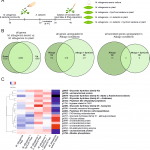Plant Science Research Weekly: May 22nd
Review: Devastating intimacy: the cell biology of plant–Phytophthora interactions
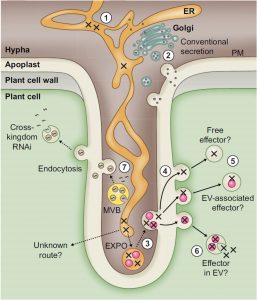 Phytophthora are plant-destroying oomycetes. Within this genus are several infamous disease-causing agents: P. infestans of the potato late-blight fame, P. sojae of soybean root rot, P. ramorum of sudden oak death, and many other lesser-known species. This fine new review by Boevink et al. explores the cellular interface between host and Phytophthora pathogens. One of the strengths of the review is that it derives insights from across the genus, highlighting the span of tools and strategies used by these pathogens, and also looks at the cell biology of both pathogen and plant host in determining success or failure of the outcome. The review also highlights both knowns and unknowns in each step of the infection process, and would be excellent reading for anyone interested in an overview of the fascinating cell-biology of this interaction. New Phytol. 10.1111/nph.16650 (Summary by Mary Williams @PlantTeaching)
Phytophthora are plant-destroying oomycetes. Within this genus are several infamous disease-causing agents: P. infestans of the potato late-blight fame, P. sojae of soybean root rot, P. ramorum of sudden oak death, and many other lesser-known species. This fine new review by Boevink et al. explores the cellular interface between host and Phytophthora pathogens. One of the strengths of the review is that it derives insights from across the genus, highlighting the span of tools and strategies used by these pathogens, and also looks at the cell biology of both pathogen and plant host in determining success or failure of the outcome. The review also highlights both knowns and unknowns in each step of the infection process, and would be excellent reading for anyone interested in an overview of the fascinating cell-biology of this interaction. New Phytol. 10.1111/nph.16650 (Summary by Mary Williams @PlantTeaching)
Review: Enzymes as parts in need of replacement – and how to extend their working life
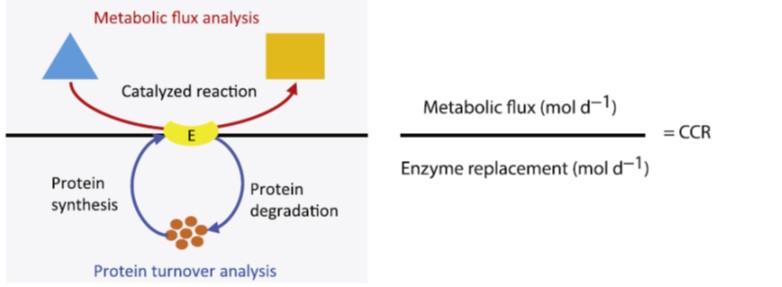 The ability of biological systems to self-repair is a huge motivator in all sorts of synthetic biology projects. Taking this cell-as-factory to the next step comes the question of how often do the parts need replacing? Tivendale et al. address this through a discussion of Catalytic Cycles until Replacement (CCR). CCR is determined by both rate of catalysis and half-life of enzyme; a slow but long-lived enzyme might have the same CCR as a fast, short-lived one. An overview of tools and methods applied to the difficult task of measuring both rates is discussed – these include metabolic flux analysis through heavy isotope labeling, fluorescently-tagged proteins, and mathematical modeling. It’s interesting to see the median estimates for CCR, protein half-life and kcat values (just for fun, make a guess before you read on). Several interesting observations: CCR ranges over seven orders of magnitude, from 1 to 107, and those with the lowest CCRs have reactive substrates or products. The review proceeds to discuss strategies to engineer enzymes with higher CCRs, through rational engineering and directed evolution. Trends Plant Sci. (Summary by Mary Williams @PlantTeaching) (How was your guess? The article finds median values for plant enzymes: CCR ~3 × 106, enzyme turnover rate 0.1 mol/day, and kcat is 10 mol/sec, or 860,000/day, and assuming enzymes work at ~30% of their kcat).
The ability of biological systems to self-repair is a huge motivator in all sorts of synthetic biology projects. Taking this cell-as-factory to the next step comes the question of how often do the parts need replacing? Tivendale et al. address this through a discussion of Catalytic Cycles until Replacement (CCR). CCR is determined by both rate of catalysis and half-life of enzyme; a slow but long-lived enzyme might have the same CCR as a fast, short-lived one. An overview of tools and methods applied to the difficult task of measuring both rates is discussed – these include metabolic flux analysis through heavy isotope labeling, fluorescently-tagged proteins, and mathematical modeling. It’s interesting to see the median estimates for CCR, protein half-life and kcat values (just for fun, make a guess before you read on). Several interesting observations: CCR ranges over seven orders of magnitude, from 1 to 107, and those with the lowest CCRs have reactive substrates or products. The review proceeds to discuss strategies to engineer enzymes with higher CCRs, through rational engineering and directed evolution. Trends Plant Sci. (Summary by Mary Williams @PlantTeaching) (How was your guess? The article finds median values for plant enzymes: CCR ~3 × 106, enzyme turnover rate 0.1 mol/day, and kcat is 10 mol/sec, or 860,000/day, and assuming enzymes work at ~30% of their kcat).
Review: Ten years of the maize nested association mapping population: Impact, limitations, and future directions
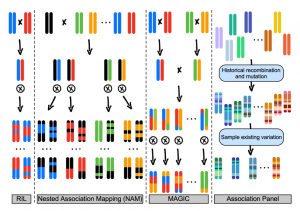 Linking phenotype to genotype is a major obstacle in plant biology, and conventional approaches (linkage analysis, association mapping) have limitations. Here Gage et al. review the past, present, and future impacts of a maize Nested Association Mapping (NAM) population developed throughout the 2000s. Designed to capitalize on the advantages while overcoming the weaknesses of traditional approaches, NAM is more powerful for detecting causal loci. The maize NAM population consists of biparental crosses conducted using the common parent B73 and 25 founder lines. After several rounds of selfing, 200 progeny were used per cross, resulting in a population of 5,000 individuals. In 2009 the population was made publicly available, representing an invaluable resource for maize researchers. Widely used for several purposes, NAM particularly facilitated identifying the genetic architecture of complex traits in maize. For example, the majority of phenotypic variation for flowering time was found to be controlled by numerous small effect loci, contrasting with observations from Arabidopsis and rice. Furthermore, from this NAM arose extensive, publicly available maize phenotyping data, and similar NAM-style approaches were incited in other species, including rice, wheat, and soybean. The synergistic, collaborative use of NAM amongst the maize community demonstrates the substantial success achievable when open science is embraced. With genome assemblies for the NAM parents recently released, the maize NAM population will advance crop improvement in the coming decade and beyond. (Summary by Caroline Dowling @CarolineD0wling) Plant Cell 10.1105/tpc.19.00951
Linking phenotype to genotype is a major obstacle in plant biology, and conventional approaches (linkage analysis, association mapping) have limitations. Here Gage et al. review the past, present, and future impacts of a maize Nested Association Mapping (NAM) population developed throughout the 2000s. Designed to capitalize on the advantages while overcoming the weaknesses of traditional approaches, NAM is more powerful for detecting causal loci. The maize NAM population consists of biparental crosses conducted using the common parent B73 and 25 founder lines. After several rounds of selfing, 200 progeny were used per cross, resulting in a population of 5,000 individuals. In 2009 the population was made publicly available, representing an invaluable resource for maize researchers. Widely used for several purposes, NAM particularly facilitated identifying the genetic architecture of complex traits in maize. For example, the majority of phenotypic variation for flowering time was found to be controlled by numerous small effect loci, contrasting with observations from Arabidopsis and rice. Furthermore, from this NAM arose extensive, publicly available maize phenotyping data, and similar NAM-style approaches were incited in other species, including rice, wheat, and soybean. The synergistic, collaborative use of NAM amongst the maize community demonstrates the substantial success achievable when open science is embraced. With genome assemblies for the NAM parents recently released, the maize NAM population will advance crop improvement in the coming decade and beyond. (Summary by Caroline Dowling @CarolineD0wling) Plant Cell 10.1105/tpc.19.00951
How far does stomatal activator and inhibitor signaling work in the plant epidermis?
 Stomata are the pores on the plant surface surrounded by a pair of guard cells that control gaseous exchange and water loss. Among the many genes involved in stomatal patterning and development, EPIDERMAL PATTERNING FACTOR 1 (EPF1) and STOMAGEN encode signaling peptides and acts as negative (inhibitor) and positive (activator) regulators of stomatal patterning respectively. However, how far these peptides function from their places of synthesis to regulate stomatal patterning is not known. In this paper, Zeng et al. used the Cre-lox system to induce genetic mosaics in which GFP and EPF1 or STOMAGEN were overexpressed in small sectors. They then examined how stomatal patterning changed both inside and outside the sector boundary using a novel computational pipeline (SPACE: Stomata Patterning AutoCorrelation on Edidermis) to determine how far these peptides function from their site of synthesis. The authors showed that the activator, STOMAGEN, acts across a short range (60 mm) compared to the inhibitor, EPF1, which acts across a long range (170 mm). In a nutshell, this paper advances our understanding of the range of activator-inhibitor signaling in stomatal development and also discusses the novel computational pipeline that can be extended to the study of various kinds of patterning mechanism. (Summary by Vijaya Batthula @Vijaya_Batthula). bioRxiv 10.1101/2020.04.29.069211
Stomata are the pores on the plant surface surrounded by a pair of guard cells that control gaseous exchange and water loss. Among the many genes involved in stomatal patterning and development, EPIDERMAL PATTERNING FACTOR 1 (EPF1) and STOMAGEN encode signaling peptides and acts as negative (inhibitor) and positive (activator) regulators of stomatal patterning respectively. However, how far these peptides function from their places of synthesis to regulate stomatal patterning is not known. In this paper, Zeng et al. used the Cre-lox system to induce genetic mosaics in which GFP and EPF1 or STOMAGEN were overexpressed in small sectors. They then examined how stomatal patterning changed both inside and outside the sector boundary using a novel computational pipeline (SPACE: Stomata Patterning AutoCorrelation on Edidermis) to determine how far these peptides function from their site of synthesis. The authors showed that the activator, STOMAGEN, acts across a short range (60 mm) compared to the inhibitor, EPF1, which acts across a long range (170 mm). In a nutshell, this paper advances our understanding of the range of activator-inhibitor signaling in stomatal development and also discusses the novel computational pipeline that can be extended to the study of various kinds of patterning mechanism. (Summary by Vijaya Batthula @Vijaya_Batthula). bioRxiv 10.1101/2020.04.29.069211
Advanced vascular function discovered in a widespread moss ($)
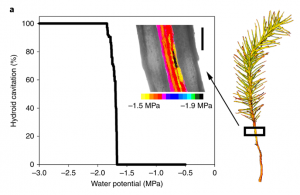 In order to grow upwards into the dry atmosphere, plants need to keep their elevated tissues hydrated and functional. In vascular plants this is achieved by a lignified water transport system in conjunction with stomatal regulation of gas exchange and the encasement of photosynthetic tissues in an impermeable cuticle. Bodribb et al. show that the widespread bryophyte Polytrichum commune possesses a vascular system that exhibits strong functional parallels with that of vascular plants. This includes water conducting cells (hydroids) that can conduct a continuous flow of water to elevated tissues, sufficient to maintain hydration and sustain steady-state photosynthesis. Hydroids are able to resist deformation even when exposed to water potentials within the operational range of angiosperm leaves, suggesting they may contain some-lignin like polymer which provides mechanical stiffness. The observed vulnerability to water-stress-induced cavitation of the vasculature of P. commune is again within the range of vascular plants, and P. commune is able to regulate transpiration to protect against cavitation. However, despite a functional vascular system and regulation of transpiration, P. commune is still not able to emerge far beyond the surface boundary layer and compete with vascular plants. The authors attribute this to the low intrinsic water use efficiency of P. commune, which renders photosynthesis highly sensitive to the regulation of transpiration that is required to avoid cavitation in a dry atmosphere. (Summary by Sophie Young @jeunesophie) Nature Plants 10.1038/s41477-020-0602-x
In order to grow upwards into the dry atmosphere, plants need to keep their elevated tissues hydrated and functional. In vascular plants this is achieved by a lignified water transport system in conjunction with stomatal regulation of gas exchange and the encasement of photosynthetic tissues in an impermeable cuticle. Bodribb et al. show that the widespread bryophyte Polytrichum commune possesses a vascular system that exhibits strong functional parallels with that of vascular plants. This includes water conducting cells (hydroids) that can conduct a continuous flow of water to elevated tissues, sufficient to maintain hydration and sustain steady-state photosynthesis. Hydroids are able to resist deformation even when exposed to water potentials within the operational range of angiosperm leaves, suggesting they may contain some-lignin like polymer which provides mechanical stiffness. The observed vulnerability to water-stress-induced cavitation of the vasculature of P. commune is again within the range of vascular plants, and P. commune is able to regulate transpiration to protect against cavitation. However, despite a functional vascular system and regulation of transpiration, P. commune is still not able to emerge far beyond the surface boundary layer and compete with vascular plants. The authors attribute this to the low intrinsic water use efficiency of P. commune, which renders photosynthesis highly sensitive to the regulation of transpiration that is required to avoid cavitation in a dry atmosphere. (Summary by Sophie Young @jeunesophie) Nature Plants 10.1038/s41477-020-0602-x
GOLVEN peptide signaling through RGI receptors and MPK6 restricts asymmetric cell division during root initiation
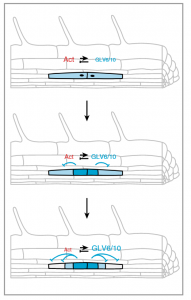 Lateral root starts development starts with an asymmetric cell division in the founder cell. In this study, Fernandez et al. explored the role of peptide signaling this process. The authors started with the previous finding that GOLVEN peptides are involved in lateral root initiation, as overexpression of GLV6 causes a strong reduction in number of emerged lateral roots as a consequence of excess asymmetric cell divisions interfering with lateral root development. The authors used this overexpression line for a suppressor screen to find downstream signaling components, and identified mutations in MITOGEN-ACTIVATED PROTEIN KINASE6 (MPK6). The authors demonstrated that GLV6 peptide treatment rapidly phosphorylates MPK6. Additionally, they identified three RGI receptors that act as GLV receptors. Overall, the work suggests a lateral root development model in which an activator induces production of GLV peptides which are perceived by RGIs and inhibit further asymmetric cell divisions through downstream MPK6 signaling. (Summary by Arif Ashraf @aribidopsis) Nature Plants 10.1038/s41477-020-0645-z
Lateral root starts development starts with an asymmetric cell division in the founder cell. In this study, Fernandez et al. explored the role of peptide signaling this process. The authors started with the previous finding that GOLVEN peptides are involved in lateral root initiation, as overexpression of GLV6 causes a strong reduction in number of emerged lateral roots as a consequence of excess asymmetric cell divisions interfering with lateral root development. The authors used this overexpression line for a suppressor screen to find downstream signaling components, and identified mutations in MITOGEN-ACTIVATED PROTEIN KINASE6 (MPK6). The authors demonstrated that GLV6 peptide treatment rapidly phosphorylates MPK6. Additionally, they identified three RGI receptors that act as GLV receptors. Overall, the work suggests a lateral root development model in which an activator induces production of GLV peptides which are perceived by RGIs and inhibit further asymmetric cell divisions through downstream MPK6 signaling. (Summary by Arif Ashraf @aribidopsis) Nature Plants 10.1038/s41477-020-0645-z
Melatonin represses oil and anthocyanin accumulation in seeds
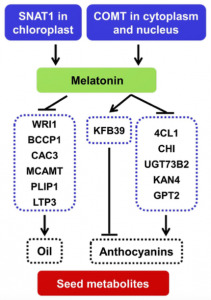 Seed oils and anthocyanins play several roles in plant physiology and are promising substances for crop engineering given their benefits for human health. Recent studies proposed that melatonin –a potent antioxidant present in all plant species– regulates the deposition of these metabolites in seeds, but the mechanism behind this is still missing. In this paper, Li et al. assessed the effects of knocking out the genes SNAT1 and COMT, which codify the enzymes in charge of synthesizing melatonin from serotonin, in the accumulation of fatty acids and anthocyanin in Arabidopsis thaliana seeds. They show that losing the function of one or both genes increased the levels of both classes of metabolites and that applying exogenous melatonin was enough to decrease them back to standard concentrations. Additionally, genes related to fatty acids and anthocyanins synthesis –rather than those implicated in their deposition– were upregulated in mutants. Taking all these results, the authors suggest that melatonin is a negative regulator for the production of seed fatty acids and anthocyanins. Moreover, they show that SNAT1 and COMT also control other seed features, like mucilage production and its proanthocyanidin content. (Summary by Carlos A. Ordóñez-Parra @caordonezparra) Plant Physiol. 10.1104/pp.20.00117
Seed oils and anthocyanins play several roles in plant physiology and are promising substances for crop engineering given their benefits for human health. Recent studies proposed that melatonin –a potent antioxidant present in all plant species– regulates the deposition of these metabolites in seeds, but the mechanism behind this is still missing. In this paper, Li et al. assessed the effects of knocking out the genes SNAT1 and COMT, which codify the enzymes in charge of synthesizing melatonin from serotonin, in the accumulation of fatty acids and anthocyanin in Arabidopsis thaliana seeds. They show that losing the function of one or both genes increased the levels of both classes of metabolites and that applying exogenous melatonin was enough to decrease them back to standard concentrations. Additionally, genes related to fatty acids and anthocyanins synthesis –rather than those implicated in their deposition– were upregulated in mutants. Taking all these results, the authors suggest that melatonin is a negative regulator for the production of seed fatty acids and anthocyanins. Moreover, they show that SNAT1 and COMT also control other seed features, like mucilage production and its proanthocyanidin content. (Summary by Carlos A. Ordóñez-Parra @caordonezparra) Plant Physiol. 10.1104/pp.20.00117
Accumulation of high value bioproducts in planta can improve the economics of advanced biofuels
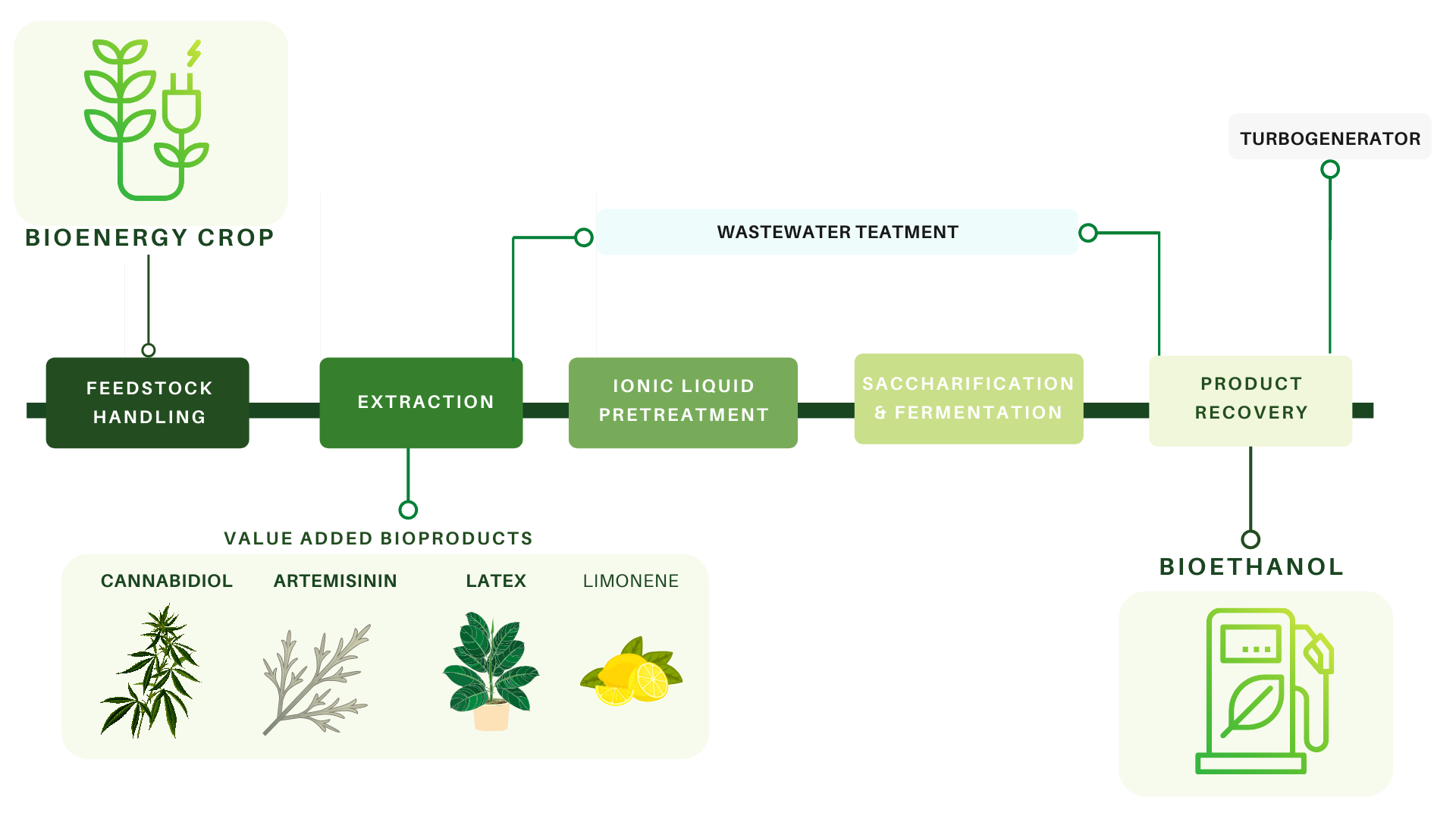 Biofuels can be obtained from bioenergy crops such as sorghum, maize and sugarcane. However, the production of bioethanol is still more expensive than that of petroleum. Given the importance of replacing conventional fossil fuels with renewable liquid fuels, the biorefinery system should be improved to reach the Minimum Ethanol Selling Price (MESP) of $2.50/galllon. One strategy relies on the diversification of cellulosic biorefineries. As the biomass feedstock represents the largest cost, bioenergy crops could be engineered to generate other commercially valuable products in addition to bioethanol. This paper highlights the importance of techno-economic models to investigate value-added compounds and direct plant metabolic engineering. The authors identified five relevant molecules -limonene, latex, PHB (polyhydroxybutyrate, a polymer for use in plastic production), cannabidiol, and artemisinin- with a wide range of market prices and applications to be incorporated in the sorghum-to-ethanol conversion process. Considering different extraction efficiencies, they also quantified the lowest amount of each coproduct in engineered plants that is needed to reach cost parity. To summarize, the required minimum accumulation of valuable molecules has already been achieved in a variety of plant species. For example, the production of PHB in leaves can reach the 4% and 18.8% of dry weight in transgenic Arabidopsis and tobacco respectively. Nevertheless, it’s worth taking into account crucial limiting factors, including the unique physiology of latex-producing plants, the storage of cytotoxic compound in specialized epithelial cells of limonene-producing plants, or the complex biosynthetic pathway of artemisinin in Artemisia annua. Besides plant biology, the marketplace should be examined: the demand of cannabidiol is expected to grow by an order-of-magnitude by 2025 despite the linear growth for other molecules. (Summary by Michela Osnato @michela_osnato) Proc. Natl. Acad. Sci. USA 10.1073/pnas.2000053117
Biofuels can be obtained from bioenergy crops such as sorghum, maize and sugarcane. However, the production of bioethanol is still more expensive than that of petroleum. Given the importance of replacing conventional fossil fuels with renewable liquid fuels, the biorefinery system should be improved to reach the Minimum Ethanol Selling Price (MESP) of $2.50/galllon. One strategy relies on the diversification of cellulosic biorefineries. As the biomass feedstock represents the largest cost, bioenergy crops could be engineered to generate other commercially valuable products in addition to bioethanol. This paper highlights the importance of techno-economic models to investigate value-added compounds and direct plant metabolic engineering. The authors identified five relevant molecules -limonene, latex, PHB (polyhydroxybutyrate, a polymer for use in plastic production), cannabidiol, and artemisinin- with a wide range of market prices and applications to be incorporated in the sorghum-to-ethanol conversion process. Considering different extraction efficiencies, they also quantified the lowest amount of each coproduct in engineered plants that is needed to reach cost parity. To summarize, the required minimum accumulation of valuable molecules has already been achieved in a variety of plant species. For example, the production of PHB in leaves can reach the 4% and 18.8% of dry weight in transgenic Arabidopsis and tobacco respectively. Nevertheless, it’s worth taking into account crucial limiting factors, including the unique physiology of latex-producing plants, the storage of cytotoxic compound in specialized epithelial cells of limonene-producing plants, or the complex biosynthetic pathway of artemisinin in Artemisia annua. Besides plant biology, the marketplace should be examined: the demand of cannabidiol is expected to grow by an order-of-magnitude by 2025 despite the linear growth for other molecules. (Summary by Michela Osnato @michela_osnato) Proc. Natl. Acad. Sci. USA 10.1073/pnas.2000053117
Rhizosphere microbiome protects plants from a pathogen via iron competition
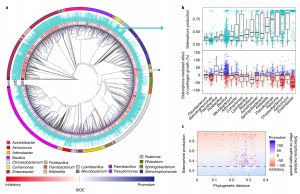 Iron is an essential element for most living organisms, including plant-associated bacteria. As iron is insoluble in most soils, many soil-borne bacteria scavenge iron using siderophores, a chemically diverse group of secondary metabolites with a high affinity for iron. Siderophores are known to drive inter-species interactions of bacteria through competition for iron. To explore the potential of siderophores produced by the rhizosphere microbiota to prevent the growth of plant pathogens, Gu et al. investigated siderophores of >2000 bacterial strains isolated from tomato plants grown in various natural sites, all infected by the soil-born pathogen Ralstonia solanacearum. They also characterized the microbiota structures of these plants. Siderophores of different bacterial isolates showed a wide range of impact (from inhibitory to promotive) on the growth of R. solanacearum in vitro. Rhizosphere microbiome analysis showed that siderophore-mediated interactions correlate with species co-occurrence in the field; the trend was especially pronounced in samples from iron-limited environments. Furthermore, they showed that bacterial isolates producing inhibitory siderophores tend to inhibit pathogen growth in planta and protect plants from disease. By combining global microbiome profiling and high-throughput strain-wise phenotyping, this study unravels the diversified effects of siderophores produced by microbiota members on pathogen growth in plants, paving the way towards microbiome-mediated plant disease prevention. (Summary by Tatsuya Nobori @nobolly) Nature Microbiology 10.1038/s41564-020-0719-8
Iron is an essential element for most living organisms, including plant-associated bacteria. As iron is insoluble in most soils, many soil-borne bacteria scavenge iron using siderophores, a chemically diverse group of secondary metabolites with a high affinity for iron. Siderophores are known to drive inter-species interactions of bacteria through competition for iron. To explore the potential of siderophores produced by the rhizosphere microbiota to prevent the growth of plant pathogens, Gu et al. investigated siderophores of >2000 bacterial strains isolated from tomato plants grown in various natural sites, all infected by the soil-born pathogen Ralstonia solanacearum. They also characterized the microbiota structures of these plants. Siderophores of different bacterial isolates showed a wide range of impact (from inhibitory to promotive) on the growth of R. solanacearum in vitro. Rhizosphere microbiome analysis showed that siderophore-mediated interactions correlate with species co-occurrence in the field; the trend was especially pronounced in samples from iron-limited environments. Furthermore, they showed that bacterial isolates producing inhibitory siderophores tend to inhibit pathogen growth in planta and protect plants from disease. By combining global microbiome profiling and high-throughput strain-wise phenotyping, this study unravels the diversified effects of siderophores produced by microbiota members on pathogen growth in plants, paving the way towards microbiome-mediated plant disease prevention. (Summary by Tatsuya Nobori @nobolly) Nature Microbiology 10.1038/s41564-020-0719-8
Fungal antagonism of Arabidopsis oomycete infection requires a previously uncharacterized secreted hydrolase
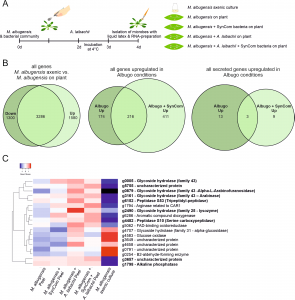 Antagonist interactions between microbes of the phyllosphere stabilize the microbiome and some “hub” organisms can exert strong effects on community structure. The yeast family Ustilaginales contains several apathogenic species that are microbial antagonists that can inhibit infection from diverse bacterial, fungal, and viral pathogens. This study by Eitzen et al. investigates the role of the epiphytic Ustilaginales yeast Moesziomyces albugensis as an antagonist of pathogenic oomycetes and the underlying mechanism of antagonism. Transcriptome analysis of M. albugensis identified nine candidate microbe-microbe effector genes; genetic deletions of candidate genes was used to assess their role as biocontrols against the oomycete Albugo laibachii. The M. albugensis Δg2490 line (g2490 encodes a secreted glycoside hydrolase “GH25”) almost completely lost its biocontrol activity against the oomycete, while genetically complemented lines restored antagonism. GH25 was previously uncharacterized and is transcriptionally activated specifically when both A. laibachii and M. albugensis are co-colonizing the surface of Arabidopsis. Further research into GH25 could help establish M. albugensis as a suitable biocontrol agent for crop protection. (Summary by Katy Dunning @plantmomkaty) bioRxiv
Antagonist interactions between microbes of the phyllosphere stabilize the microbiome and some “hub” organisms can exert strong effects on community structure. The yeast family Ustilaginales contains several apathogenic species that are microbial antagonists that can inhibit infection from diverse bacterial, fungal, and viral pathogens. This study by Eitzen et al. investigates the role of the epiphytic Ustilaginales yeast Moesziomyces albugensis as an antagonist of pathogenic oomycetes and the underlying mechanism of antagonism. Transcriptome analysis of M. albugensis identified nine candidate microbe-microbe effector genes; genetic deletions of candidate genes was used to assess their role as biocontrols against the oomycete Albugo laibachii. The M. albugensis Δg2490 line (g2490 encodes a secreted glycoside hydrolase “GH25”) almost completely lost its biocontrol activity against the oomycete, while genetically complemented lines restored antagonism. GH25 was previously uncharacterized and is transcriptionally activated specifically when both A. laibachii and M. albugensis are co-colonizing the surface of Arabidopsis. Further research into GH25 could help establish M. albugensis as a suitable biocontrol agent for crop protection. (Summary by Katy Dunning @plantmomkaty) bioRxiv



